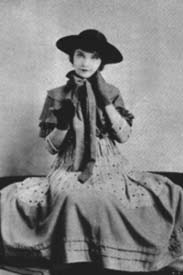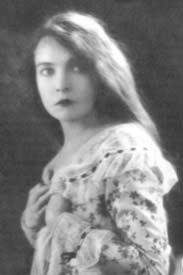LILLIAN
GISH
GREATEST
FEMALE MOVIE ACTRESS
  |
BIOGRAPHY
Birth
Name:
Lillian
Diana de Guiche
Born:
October
14, 1893 in Springfield, Ohio
Died:
February
27, 1993 in New York, New York
Not only was Lillian Gish born in the right era, but
she was also born with the ethereal beauty and grace to make her a star
in the silent film industry. If Mary Pickford was the silent cinema's
greatest personality, Lillian was its greatest actress.
|
A
consummate actress, Lillian seemed to take delight in suffering for the art form
that became her obsession. In order to experiment, Lillian worked in extreme
conditions such as starvation, intense heat and bitter cold. Soon, she became
the quintessential silent screen heroine, lovely and open to suffering. However,
despite her characters' apparent weakness, Lillian's performances also let their
inner strengths shine through.
Her stage debut took place in 1902 when she performed at The
Little Red School House in Rising Sun, Ohio. From 1903 to 1904, with her mother
and her sister Dorothy, Lillian toured in Her First
False Step. The following year, she danced with the
Sarah Bernardt production in New York City. From 1908 to 1911 she moved around,
staying with various relatives. She lived with her aunt in Massillon, Ohio, with
her mother in East St. Louis and briefly with her father in Oklahoma.
Lillian's film debut came in 1912, when she and her sister
starred in An Unseen Enemy
under the direction of D.W. Griffith. In 1913, during the production of A
Good Little Devil, Lillian collapsed from anemia
during a run of the play.
That
same year, in The
Mothering Heart,
Lillian started showing signs of the emotional power hidden in the seemingly
frail and hauntingly beautiful actress. Griffith utilized Lillian's aura to its
fullest to develop the image of the suffering heroine. She also demonstrated an
intense anger as shown in the same film, when she beats a bush after the death
of her child. This intensity was present in all her films thereafter. Broken
Blossoms
is arguably Lillian's greatest silent film. The terror she expressed as her
drunken father breaks down the door to the closet she was hiding in was
communicated directly to the audience. She displayed that same intensity in Way
Down East,
when she baptizes a dying baby and in The
Wind,
where she roams, dying, through the streets of Montmartre. In 1920, she directed
Dorothy Gish in
Remodeling Her Husband
and in 1922 she made Orphans
in the Storm,
her last film under Griffith's direction. She joined Metro-Goldwyn-Mayer in 1924
and made her first "talkie"
One Romantic Night
in 1930. She then returned to the stage in Uncle Vanya.
During the 1930s Lillian began working in radio. She made
her television debut in 1948 with the Philco Playhouse production
The Late Christopher Bean. In 1969, Lillian began
giving the film lecture "Lillian Gish and the Movies: The Art of Film,
1900-1928."
Lillian has been honored with many of the motion picture
industry's top honors, including an honorary Academy Award, The American Film
Institute Life Achievement Award and the D.W. Griffith Award for lifetime
achievement.
Lillian's combination of fragility and strength, as well as
her rare beauty and brilliant performance on screen, made her one of the
greatest stars in silent films. She will always be remembered
as one of the pioneers in the motion pictures industry.
My Favorite
Lillian Gish Film
Way Down East
(1920) American
C/B&W : 13 reels
Directed by D.W.
Griffith
Cast: Lillian
Gish [Anna Moore], Richard
Barthelmess [David Bartlett], Mrs. David Landau [Mrs. Moore], Lowell Sherman
[Lennox Sanderson], Burr McIntosh [Squire Bartlett], Josephine Bernard [Mrs.
Tremont], Mrs. Morgan Belmont [Diana Tremont], Patricia Fruen [Diana’s
sister], Florence Short [eccentric aunt], Kate Bruce [Mrs. Bartlett], Vivia
Ogden [Martha Perkins], Porter Strong [Seth Holcomb], George Neville [Reuben
Whipple], Edgar Nelson [Hi Holler], Mary Hay [Kate Brewster], Creighton Hale
[Professor Sterling], Emily Fitzroy [Maria Poole]; David Landau, Carol Dempster,
Una Merkel, Norma Shearer, Alice Shearer, Athole Shearer
D.W. Griffith, Incorporated, production; distributed by United Artists
Corporation. / Produced by D.W.
Griffith. Scenario by Anthony Paul Kelly, from the play adaptation Way Down
East by Lottie Blair Parker and Joseph R. Grismer of the play Annie Laurie by
Lottie Blair Parker. Art direction by Charles O. Seessel and Clifford Pember.
Set construction by Clark Robinson. Gowns by Lady Duff Gordon. Furs by Otto
Kahn, Incorporated. Lillian
Gish’s gowns by Mrs. O’Kane Conwell. Associate director Elmer Clifton.
Assistant directors Herbert Sutch and Frank Walsh. Technical direction by Frank
‘Huck’ Wortman. Production assistance by Leigh Smith. Cinematography by G.W.
Bitzer, Hendrik Sartov and Paul H. Allen. Decorative titles by Victor Georg.
Edited by James Smith and Rose Smith. Original music score arranged by Louis
Silvers and William Frederick Peters. Presented by D.W.
Griffith. / © 3 September 1920 by D.W. Griffith, Incorporated [LP15906].
Previewed August 1920 in Middletown, New York and Kingston, New York. Premiere 3
September 1920 at the 44th Street Theatre in New York, New York. General release
21 August 1921. / Standard 35mm spherical 1.37:1 format. Technicolor [process
two] two-strip color process sequences. / Some footage shot near White River
Junction, Vermont. Clarine Seymour appeared in footage early in the film’s
production, but the footage was reshot and her role was assumed by Mary Hay
after Seymour’s death. The film was shown on a road show basis by Griffith
before being turned over to United Artists for general release. The film was
rereleased in 1931 with synchronized music and sound effects. The film was
restored in 1985 to 148 minutes by the Museum of Modern Art. / Print exists in
the Museum of Modern Art film archive.

